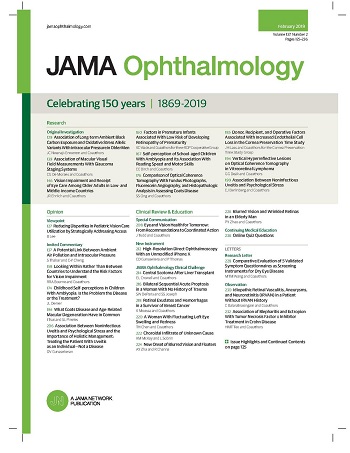Orthokeratology, 0.04% Atropine, and 0.01% Atropine for Myopia Control: A Randomized Clinical Trial.
IF 9.2
1区 医学
Q1 OPHTHALMOLOGY
引用次数: 0
Abstract
Importance Investigating the antimyopia efficacy and safety of orthokeratology and varying atropine doses in specific age groups could optimize personalized treatment choices. Objective To evaluate the efficacy and safety of orthokeratology, 0.04% atropine, and 0.01% atropine in controlling myopia among older children and adolescents over a 2-year treatment period. Design, Setting, and Participants This 3-arm, parallel-design, multicenter randomized clinical trial was conducted from June 2021 to August 2023 at the Shanghai Eye Disease Prevention and Treatment Center and the Shanghai Ninth People's Hospital. A total of 209 children aged 8 to 15 years with refractive errors between -1.0 diopter (D) and -4.0 D were enrolled in this study. Primary data analysis was conducted from December 2024 to January 2025, with additional analysis conducted from April 2025 to May 2025. Interventions Atropine, 0.01% or 0.04%, administered daily, or overnight orthokeratology for 2 years. Main Outcomes and Measures The primary outcome was 2-year axial length (AL) growth. Results Among 209 children enrolled in this study, mean (SD) age was 10.5 (1.79) years, and 104 participants (49.8%) were female. Mean (SD) spherical equivalent (SE) was -2.55 (0.85) D, and mean (SD) AL was 24.7 (0.79) mm. Of 209 enrolled children, 48 of 69 in the 0.01% atropine group (69.6%), 48 of 68 in the 0.04% atropine group (70.6%), and 53 of 72 in the orthokeratology group (73.6%) completed the 2-year follow-up. Children receiving 0.04% atropine had a significantly reduced AL increase than those receiving 0.01% atropine (difference, 0.18 mm; 95% CI, 0.11-0.26; P < .001). Nonsignificant but clinically meaningful difference was found between the 0.01% atropine group and the orthokeratology group (difference, 0.08 mm; 95% CI, 0.003-0.15; P = .04). Regression analyses revealed that older age was associated with less AL growth for all groups, while a more myopic SE at baseline predicted slower axial elongation for the orthokeratology group. The 0.04% atropine group had a higher risk of photophobia than the 0.01% atropine group (11 of 48 patients [22.9%] vs 1 of 48 patients [2.1%], respectively; difference, 20.8%; 95% CI, 8.3%-33.4%; P = .002). In the orthokeratology group, 19 of 72 participants (26.4%) showed slight corneal fluorescein staining. Conclusions and Relevance In this randomized clinical trial of participants aged 8 to 15 years, 0.04% atropine was more effective than 0.01% atropine or orthokeratology to control myopia, despite a higher incidence of photophobia. These findings support 0.04% atropine as a superior treatment compared with orthokeratology or 0.01% atropine for older children and adolescents with myopia similar to those enrolled in this trial, although longer-term follow-up is warranted. Trial Registration ClinicalTrials.gov Identifier: NCT05357326.角膜塑形镜、0.04%阿托品和0.01%阿托品用于近视控制:一项随机临床试验。
研究角膜塑形术和不同剂量阿托品在特定年龄组的抗近视疗效和安全性,可以优化个性化的治疗选择。目的评价角膜塑形镜、0.04%阿托品和0.01%阿托品在2年治疗期间控制大龄儿童和青少年近视的疗效和安全性。设计、环境和参与者这项三臂、平行设计、多中心随机临床试验于2021年6月至2023年8月在上海眼病防治中心和上海第九人民医院进行。本研究共纳入209名8 - 15岁屈光不正在-1.0 ~ -4.0 D之间的儿童。初步数据分析时间为2024年12月至2025年1月,补充分析时间为2025年4月至2025年5月。干预:沙托品,0.01%或0.04%,每日给药,或过夜角膜塑形术,持续2年。主要结局和测量:主要结局为2年轴长(AL)生长。结果209例儿童入组,平均(SD)年龄为10.5(1.79)岁,女性104例(49.8%)。平均(SD)球形当量(SE)为-2.55 (0.85)D,平均(SD) AL为24.7 (0.79)mm。209名入组儿童中,0.01%阿托品组69名中有48名(69.6%),0.04%阿托品组68名中有48名(70.6%),角膜矫正组72名中有53名(73.6%)完成了2年随访。与0.01%阿托品组相比,0.04%阿托品组AL升高明显降低(差异0.18 mm;95% ci, 0.11-0.26;p < 0.001)。0.01%阿托品组与角膜塑形术组差异无统计学意义(差异0.08 mm;95% ci, 0.003-0.15;p = .04)。回归分析显示,年龄越大,所有组AL生长越少,而基线时近视SE越高,角膜塑形术组轴向伸长越慢。0.04%阿托品组畏光风险高于0.01%阿托品组(11 / 48例[22.9%]vs 1 / 48例[2.1%]);差异,20.8%;95% ci, 8.3%-33.4%;p = .002)。在角膜矫正组,72名参与者中有19名(26.4%)出现轻微的角膜荧光素染色。结论与相关性在这项年龄为8 - 15岁的随机临床试验中,0.04%阿托品比0.01%阿托品或角膜塑形镜更有效地控制近视,尽管恐光发生率更高。这些研究结果支持0.04%阿托品比角膜塑形术或0.01%阿托品更适用于年龄较大的近视儿童和青少年,尽管需要长期随访。临床试验注册号:NCT05357326。
本文章由计算机程序翻译,如有差异,请以英文原文为准。
求助全文
约1分钟内获得全文
求助全文
来源期刊

JAMA ophthalmology
OPHTHALMOLOGY-
CiteScore
13.20
自引率
3.70%
发文量
340
期刊介绍:
JAMA Ophthalmology, with a rich history of continuous publication since 1869, stands as a distinguished international, peer-reviewed journal dedicated to ophthalmology and visual science. In 2019, the journal proudly commemorated 150 years of uninterrupted service to the field. As a member of the esteemed JAMA Network, a consortium renowned for its peer-reviewed general medical and specialty publications, JAMA Ophthalmology upholds the highest standards of excellence in disseminating cutting-edge research and insights. Join us in celebrating our legacy and advancing the frontiers of ophthalmology and visual science.
 求助内容:
求助内容: 应助结果提醒方式:
应助结果提醒方式:


